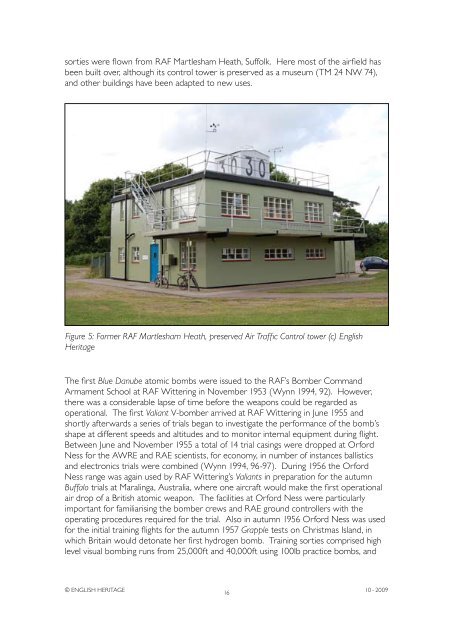Atomic Weapons Research Establishment. Orford ... - English Heritage
Atomic Weapons Research Establishment. Orford ... - English Heritage
Atomic Weapons Research Establishment. Orford ... - English Heritage
You also want an ePaper? Increase the reach of your titles
YUMPU automatically turns print PDFs into web optimized ePapers that Google loves.
sorties were flown from RAF Martlesham Heath, Suffolk. Here most of the airfield has<br />
been built over, although its control tower is preserved as a museum (TM 24 NW 74),<br />
and other buildings have been adapted to new uses.<br />
Figure 5: Former RAF Martlesham Heath, preserved Air Traffic Control tower (c) <strong>English</strong><br />
<strong>Heritage</strong><br />
The first Blue Danube atomic bombs were issued to the RAF’s Bomber Command<br />
Armament School at RAF Wittering in November 1953 (Wynn 1994, 92). However,<br />
there was a considerable lapse of time before the weapons could be regarded as<br />
operational. The first Valiant V-bomber arrived at RAF Wittering in June 1955 and<br />
shortly afterwards a series of trials began to investigate the performance of the bomb’s<br />
shape at different speeds and altitudes and to monitor internal equipment during flight.<br />
Between June and November 1955 a total of 14 trial casings were dropped at <strong>Orford</strong><br />
Ness for the AWRE and RAE scientists, for economy, in number of instances ballistics<br />
and electronics trials were combined (Wynn 1994, 96-97). During 1956 the <strong>Orford</strong><br />
Ness range was again used by RAF Wittering’s Valiants in preparation for the autumn<br />
Buffalo trials at Maralinga, Australia, where one aircraft would make the first operational<br />
air drop of a British atomic weapon. The facilities at <strong>Orford</strong> Ness were particularly<br />
important for familiarising the bomber crews and RAE ground controllers with the<br />
operating procedures required for the trial. Also in autumn 1956 <strong>Orford</strong> Ness was used<br />
for the initial training flights for the autumn 1957 Grapple tests on Christmas Island, in<br />
which Britain would detonate her first hydrogen bomb. Training sorties comprised high<br />
level visual bombing runs from 25,000ft and 40,000ft using 100lb practice bombs, and<br />
© ENGLISH HERITAGE<br />
16<br />
10 - 2009

















